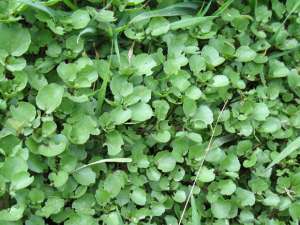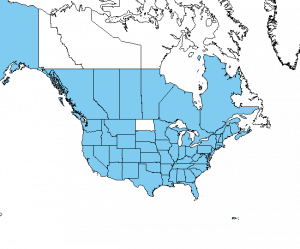Watercress (Nasturtium officinale) is an edible water plant that commonly occurs throughout the United States, southern Canada, Europe and Asia. It's actually native to Europe and Asia and naturalized elsewhere.
It has also been widely cultivated and is available as a commercial green in some areas.
It's in the Brassicaceae (formerly Cruciferae) family, which makes it a mustard like its relatives kale, cabbage, collard greens, arugula, broccoli, and of course mustard.
Another very similar wild relative is hairy bittercress.
Like most mustards, watercress has a spicy peppery flavor.
All parts of the plant are edible.
Identification
Watercress grows 4 to 10 inches high.
Leaves: The alternate, pinnately compound leaves can be from about 1.5 inches to 6.5 inches long and consist of 2 to 8 nearly oval-shaped leaflets arranged in opposite pairs with one larger leaflet on the end. The leaflet edges are wavy.
Flowers: It has small, white, 4-petal flowers with yellow stamens.
The flowers grow in long clusters along the stem like many other mustards. It flowers from March to October.
Seeds: Like other cresses and mustards, watercress flowers eventually yield long, narrow, erect green seed pods, or siliques.

Only collect watercress from clean water sources.
Nutrition
Watercress has been called a superfood, and according to the USDA and nutritionvalue.org, it's rich in several vitamins and minerals. Here are a few:
Vitamin C: 43mg/100g (48% daily value)
Vitamin A: 3191 IU/100g (64% daily value)
Vitamin B6: .129 mg/100g (10% daily value)
Vitamin K: 25 µg/100g (208% daily value)
Calcium: 120 mg/100g (9% daily value)
And like pine needle tea, we know of at least one historical account indicating that it has been used to treat scurvy.
James Cook, a British naval captain who charted New Zealand and the Great Barrier Reef in 1770, regularly fed his crews watercress:
"During all his voyages, Cook successfully fought scurvy, a deadly disease caused by vitamin deficiency, by feeding his crew a diet that included watercress, sauerkraut and orange extract." - biography.com
Range
The USDA Natural Resources Conservation map indicates that watercress occurs throughout all of the continental United States except for North Dakota. Watercress is also considered "noxious and invasive" in 46 states.
I'm not sure how North Dakota may have resisted the invasion, but I find it hard to believe.

Habitat
Watercress grows in shallow, cold running water that's slightly alkaline.
In areas where the water and soil are acidic, look for it downstream of old spring boxes or other concrete structures that raise the pH of the water.
It typically occurs all year, but the cold of winter usually beats it back to a point that makes it difficult to gather in quantity, and the heat of summer makes it hot and bitter.
That makes spring and fall the ideal seasons to forage watercress.
How to harvest
It's important, especially when eating watercress raw, to take it only from water that's been tested and is known to be clean.
Otherwise, you risk eating harmful parasites, pathogens, and toxins, including liver flukes and giardia.
The easiest way to harvest is to cut its stems at the waterline with scissors. It's also easy to gather by pulling clumps out by the roots if you don't mind cutting the roots off later.
Watercress is best used fresh but can be kept indefinitely in water if the water is changed daily. It also does well in wet soil.
It's good raw in salads or as a cooked green and can be used any way cultivated mustard is used.